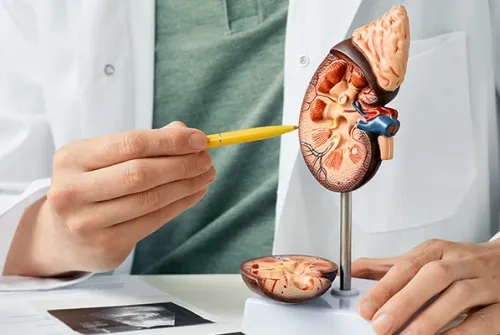Alo Yeditepe
Alo Yeditepe
The Rate Of Kidney Stones Has Begun To Increase In Women
Although kidney stones, which affect the quality of life seriously, are mostly seen in men, a recent study revealed that the rate of stone formation in women increased. Urology Specialist evaluated the reasons behind the increase in the rate of kidney stones in women according to the 'Gender Differences in Urinary Tract Stones' study conducted in the USA in 2021.
Reminding that kidney stones are one of the most common problems in urology, Urology Specialist Assoc. Prof. Dr. İlter Alkan said that the fact that our country is in the kidney stone belt has brought this problem to an even more important point. Reminding that the probability of kidney stone formation in a person is 5-10 percent throughout his life, Yeditepe University Kozyatağı Hospital Urology Specialist said, “We encounter kidney stones around 10 percent in men and 7-8 percent in women. However, with the 'Sex in Urinary Tract Stones' research conducted in the USA, we see that these rates have changed. According to the results of the research, while the rate seen in men was around 350 per hundred thousand, it was around 170 per hundred thousand in women. This is an explanation of the great increase in women,” he said.
WHAT IS THE CAUSE OF THE INCREASE IN WOMEN?
Stating that there may be many different reasons behind the recent increase in kidney stones in women, Urology Specialist continued his words as follows: “The fact that urinary tract infections are more common in women may be a reason for this result. However, one of the factors is that infection stones are more common in women than in men. However, lifestyle changes that can be seen in both genders, wrong diets, nutritional errors and consuming less liquid, which is one of the most important points, can also be among the reasons that affect the result”.
“SINCE TURKEY IS IN A HOT REGION, THE RATE OF STONE OCCURANCE IS HIGH”
Expressing that the occurance of kidney stones varies from country to country and depending on the geography, Urology Specialist said, “Urinary tract stones are more common in hot countries. Since Turkey is located in a warm geography, the rate of stone incidence is even higher in people living here".
THE SIZE OF THE STONE DEFINES THE TREATMENT
Urology Specialist gave the following information on the subject: “For example, if the stone has fallen into the urinary tract and is below 0,5 millimeters, it is likely to pass on its own. However, if it is greater than this rate, it may be necessary to use endoscopic (closed) surgical methods. While we used the open surgery method in stone treatment in the past, today we can complete the treatment with closed surgeries without making any incisions in the body or using very small incisions. In stones up to 3 cm in the kidney, the stone can be broken completely with the holmium laser by entering the kidney closed with a very thin and bendable device through the urinary tract called flexible uretorenoscopy. We can achieve very effective results with the mini-perc method in stones larger than 3 cm.”
“REDUCED DAMAGE TO KIDNEYS WITH MINI-PERC”
Urology Specialist gave the following information on the subject: “Mini Perc is a technique of entering the kidney with a thin tube by creating an incision of 3-0.3 cm from the skin. After entering the kidney, the stones are completely cleaned by melting / breaking with Holmium laser. In this method, the diameter of the mini-perc device is reduced by half compared to the device (nephroscope) used in normal percutaneous surgery. As a result, the probability of kidney damage while entering the kidney is considerably reduced, and the rate of complete stone-free (complete clearance of stones) from 0.5 to 75 percent can be achieved. Again, the risk of bleeding is very low compared to normal percutaneous surgery. Moreover, it can be applied to patients of all ages. Another important advantage and gain of this method is that the patients can continue their daily lives after being discharged in a day or two.”
EVEN IF TREATED, IT CAN RELAPSE
Reminding that the risk of stone formation is 50 percent in 5 years, Urology Specialist said, “In 10 years, this reaches 80-90 percent. Therefore, after dropping the stone once, the risk of recurrence is half. The importance of this issue is enormous. In addition, even if a stone occurs again in a person who was treated with the Mini-Perc method, it can still be treated using the same method”.
“PATIENT FOLLOW-UP AND STONE ANALYSIS IS CRUCIAL!
Yeditepe University Hospitals Urology Specialist concluded his words as follows: “Detection of the type of stone is important for the precautions to be taken for the next periods, which is mostly neglected. With metabolic (blood and urine analysis) studies, we start drug treatment if necessary to prevent the stone from recurring, and we warn about changes in the patient's lifestyle (such as diet). Among the reasons that cause stone formation, consuming less liquid, obesity and wrong diets can be listed.
This content was prepared by Yeditepe University Hospitals Medical Editorial Board.
”
See Also
- ThuFLEP Treatment Improves Quality of Life in Benign Prostatic Hyperplasia
- Treatment of Urinary System Stones with Thulium Fiber Laser
- ThuFLEP Method in Benign Prostate Enlargement
- What is Prostate Cancer? Symptoms and Treatment
- What is Benign Prostatic Hyperplasia, How is it Treated?
- Early Diagnosis Saves Lives in Insidiously Progressing Kidney Tumors
- HoLEP Eliminates 85 percent of Drug Use in the Treatment of Benign Prostate Enlargement
- Chronic Pelvic Pain
- One in Every Four Men Diagnosed with Cancer Has Prostate Cancer
- Ways to Protect Prostate Health
- Surgical Treatment of Prostate Diseases
- Ways to Get Rid of Kidney Stones
- Prostate Preventive Cancer Treatment: Focal HIFU
- HIFU Focal Treatment for Prostate Cancer
- The Things You Should Know About Prostate Cancer
- HoLEP Method in Closed Prostate Surgery
- Benign Prostate Enlargement
- Who Can Undergo HoLEP Procedure?
- 6 Misconceptions About Kidney Stones
Alo Yeditepe


